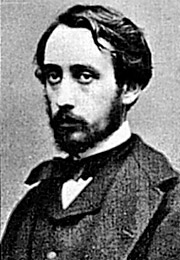


Oil on canvas
75.5 x 86.0 cm. (29 3/4 x 33 7/8 in.)
frame: 94.5 x 105.2 x 8.3 cm (37 3/16 x 41 7/16 in.)
L.1988.62.10
Signed in red, lower right: Degas
Estate of Edgar Degas, sold at auction, Galerie Georges Petit, Tableaux, pastels et dessins par Edgar Degas et provenant de son atelier, dont la vente aux enchères publiques, après décès de l’artiste, 6–8 May 1918, no. 98; [sold to Ambroise Vollard (1867–1939), Paris]; possibly by descent to de Galéa heirs, Paris. Robert de Bolli, Paris, possibly a dealer or agent; sold to Henry Pearlman, 30 May 1959; Henry and Rose Pearlman Foundation, after 1974.
Conservator’s Note
To achieve a dry, pastel look, some of the oil was leached out of the paint before it was applied. The pattern for the background wallpaper was made by first brushing on a faint wash of red paint for the background, and then applying spots of gray and orange paint with the fingers (some fingerprints are visible under magnification).
Beginning in the late 1880s, Degas frequently portrayed women bathing or drying themselves. This is among the most unstable, daring poses in the series. Although the artist sometimes used live models, he usually based the figures on drawings. Here, the body is generalized, suggesting that the painting may have been created from memory or from a sketch.

Edgar Degas (1834-1917)
Although he preferred being characterized as a “realist,” Edgar Degas (1834–1917) is nevertheless indelibly associated with Impressionism. Like other members of that circle, Degas sought to capture the experience of contemporary life with fresh eyes, yet his strong emphasis on urban subject matter and linear contours set him apart. Extremely experimental in his techniques in a variety of media (including painting, pastels, print-making, and sculpture), Degas melded lessons from his classical training with a scientific interest in analyzing movement, resulting in a radically new visual syntax. The human figure remained a constant focus for Degas, and he depicted Parisians across the social gamut caught in moments of action, whether at work or at leisure.
Degas was born in Paris to a wealthy banking family. His artistic talents were apparent from an early age, and although he briefly studied law he soon turned toward art as a full-time pursuit. He began by drawing from 15th- and 16th-century Italian masters at the Louvre, and in 1854 he joined the atelier of Louis Lamothe, a painter who had studied with Ingres. After training at the École des Beaux-Arts, Degas spent several years traveling in Italy. These formative experiences solidified his lifelong dedication to the primacy of line and rigorous composition. Degas shifted his focus from classical to contemporary themes in the 1860s. He was particularly drawn to subjects such as horse races and café-concerts, dynamic scenes that he emphasized with unexpected vantage points and eccentric cropping. He was also fascinated by the body language of figures absorbed in their work, including rehearsing ballet dancers, laundresses, and milliners. Degas’s dedication to modern subjects and techniques led him to exhibit with the Impressionists (in seven of their eight shows) between 1874 and 1886, despite his dislike for being categorized as an Impressionist.
In the late 1880s, Degas’s eyesight began declining. His colors grew more intense, line became more independent from form, and his subjects’ poses became more angular and even distorted. This work marked a departure from his earlier emphasis on naturalism, bringing him closer to Symbolist use of color and presaging elements of Expressionism. In his late career, nudes and especially bathers dominated. Depicting women captured in private moments while attending to their toilette, Degas imbued these late works with a particularly tactile quality, while also working on versions in sculpture. Degas’s unorthodox treatment of the female figure has inspired heated critical debate about whether they represent misogynistic or feminist ideas.